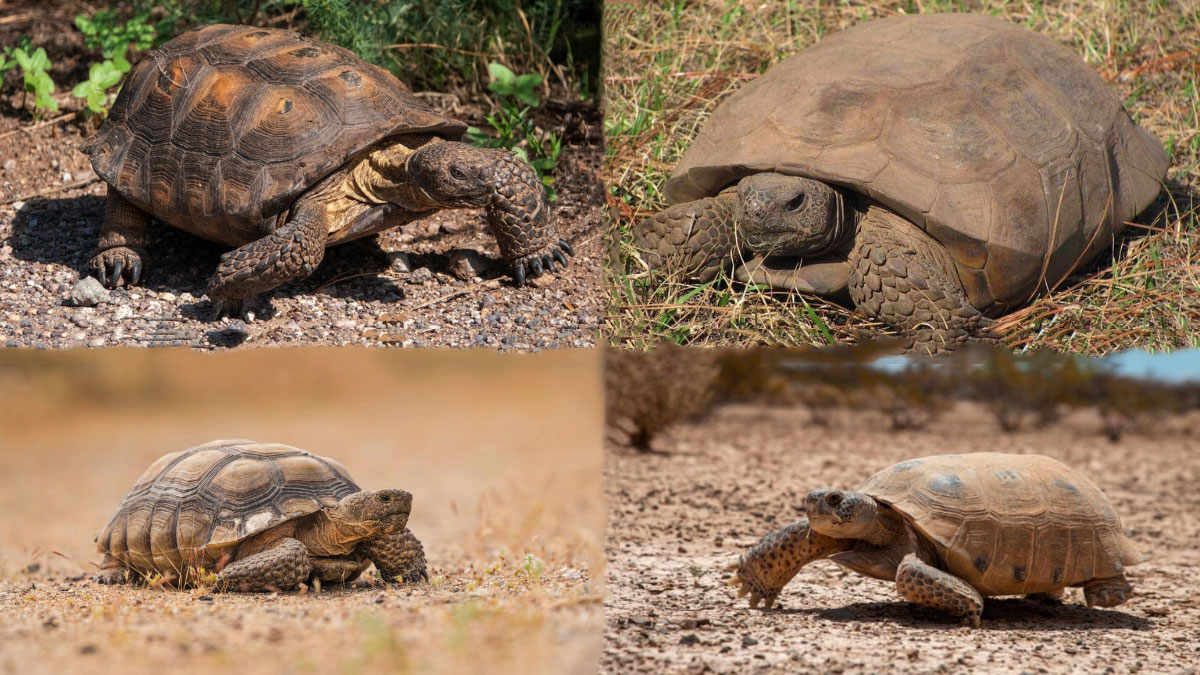Let’s Discover The Types Of Tortoise Species In The United States!
Tortoises, also known as land turtles, are fascinating reptiles that have
captured the attention of people for centuries. These creatures are unique in many ways, and they play an essential role in maintaining the delicate balance of ecosystems around the world, including the United States.
Did you know the United States is home to various types of tortoise species? There are five native tortoise species in the United States, and each can be found in a different region. Some of the most well-known species include the Desert tortoise, Gopher tortoise, and Bolson tortoise.
In this article, we’ll take a closer look at the types of tortoise species in the United States. We will also discover more about their special habitats, behavior, and conservation status. So let’s start now!
5 Types Of Tortoise Species That Occur In The United States
Contents
Tortoises are interesting creatures that have been captivated by humans for years. They are known for their sluggish movement, wrinkled skin, and hard shells. There are a variety of tortoise species in the United States, each with unique physical traits and environmental adaptations.
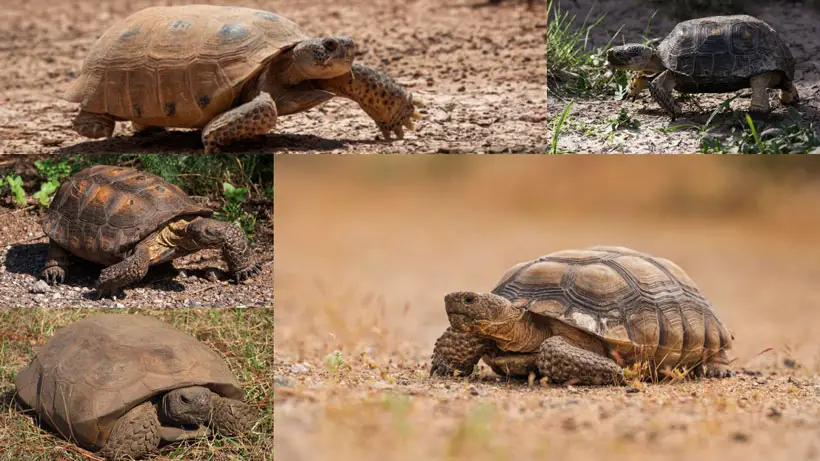
While some are expert diggers, others have evolved to survive in arid environments. However, did you know that according to the Desert Tortoise Preserve Committee, there are five officially recognized species of tortoise in the United States?
Look at the table below for further information on the different species of tortoise that can be found in the United States.
| Tortoise Species | Scientific Name | Physical Traits | Lifespan | Distribution in the USA |
|---|---|---|---|---|
| Gopher Tortoise | Gopherus polyphemus | They are large-sized tortoises (9-15 inches) with a flattened carapace and sturdy, elephant-like legs | 60 years | Found in the Southeastern US. |
| Bolson Tortoise | Gopherus flavomarginatus | They are large-sized tortoises(9-15 inches)with flat front legs and a high-domed brownish shell. | 80 years | Found in Texas. |
| Desert Tortoise | Gopherus agassizii | They are medium-sized tortoises(8-10 inches) and has a domed-shaped, greenish to dark brown shell. | 100 years | Found in the desert regions of the Southwestern US. |
| Sonoran Desert Tortoise | Gopherus morafkai | It grows to be 8-10 inches in length. They have sturdy legs and dome-shaped shells that are usually brown or tan in color. | 80 years | Found in the Sonoran Desert, which spans across parts of California and Arizona. |
| Texas Tortoise | Gopherus berlandieri | They are medium-sized (8-11 inches) and have a dark-colored, smooth shell and a flattened head. | 50 years | Found in arid regions of Texas. |
1. Gopher Tortoise
The Gopher Tortoise is a sizable terrestrial turtle that has been cruising the planet for millions of years. Its name comes from its ability to create large tunnels in sandy soils, much like a gopher.
- Scientific name: Gopherus polyphemus.
- Range and Habitat Preference: Keep a watch out for a Gopher tortoise if you ever find yourself exploring the dry, sandy regions in the Southeast of the United States.
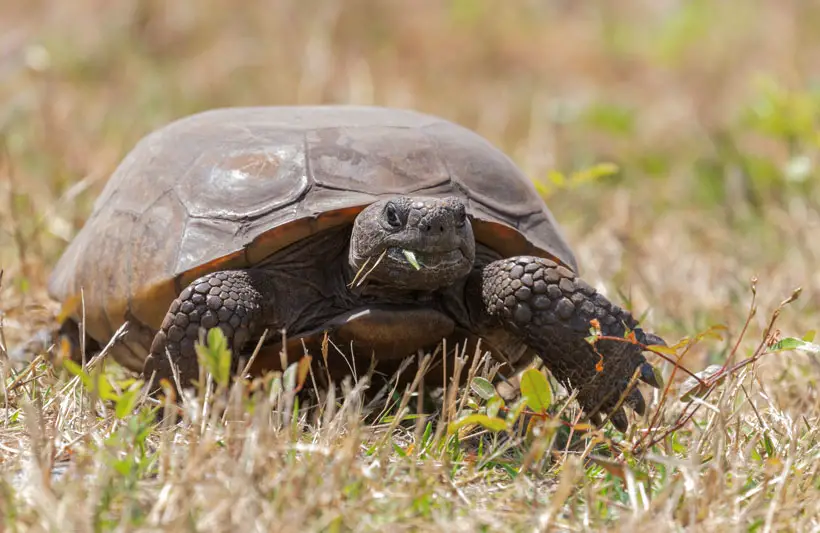
They are found in the states of Florida, Georgia, Alabama, Mississippi, Louisiana, and South Carolina.
- Physical Characteristics: They are one of the largest terrestrial tortoises in the area, growing to a length of 15 inches and weighing up to 15 pounds.
- Mating and Breeding: During the breeding season in the spring, once the male tortoise finds a mate, the female will dig a shallow nest in the sand and lay up to 15 eggs. After 80–100 days of incubation, the hatchlings will leave their sandy nest and begin their lives.
- Diet: Gopher Tortoises are herbivorous reptiles. They primarily feed on shrubs, vines, berries, and leaves. Their diet often consists of a variety of plant species found in their habitat.
- Lifespan: Although they move slowly, they are adept at avoiding predators and can live in the wild for up to 60 years.
- Special Characteristic(s): They are skilled diggers, capable of digging holes up to 40 feet long and 10 feet deep, thanks to their unique, domed shell, strong feet, and extended claws!
- Conservation Status: A study found that these species have become more vulnerable as hurricanes and tropical storm surges have become more intense. As a result, this species of turtle is listed by the IUCN as Vulnerable.
2. Bolson Tortoise
A fascinating animal known as the Bolson Tortoise lives deep within Brazil’s lush rainforests. Check out the details below if you want to learn more about this magnificent species.
- Scientific name: It is scientifically known as Gopherus flavomarginatus.
- Physical Traits: Bolson Tortoises are amazing reptiles that have evolved to survive in the hostile and dry Chihuahuan Desert. They have strong claws and beautiful brownish-yellow shells that make them ideally suited for burrowing and traversing steep terrain.
- Lifespan: They have a lifespan of 80 years.
- Diet: As herbivores, they feast on the bountiful desert plants and can go for long periods without water.
- Mating and Breeding: When it’s time for breeding, females can lay multiple clutches of 1-3 eggs each, which take around 90 days to hatch.
- Range and Habitat Preferance: The Bolson Tortoise is mostly found in the dry regions of the southwestern United States, specifically the Chihuahuan Desert, which crosses parts of New Mexico and Texas.
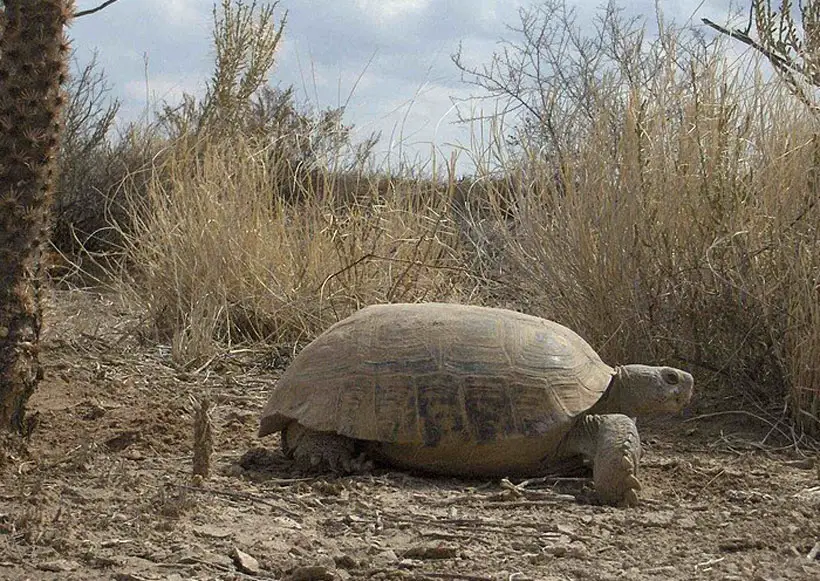
They also prefer dwelling in rocky areas with limited vegetation, scrubby deserts, and dry grasslands.
- Special characteristics: Bolson tortoises are renowned for their enormous size and unusual shell shape. They can weigh more than 20 pounds and reach a length of up to 15 inches.
Additionally, they can store water in their bladders to stay hydrated in the scorching desert heat.
- Conservation Status: Poaching and the illegal pet trade pose a threat to the survival of Bolson tortoises. As a result, the Bolson Tortoise is classified as “Vulnerable” on the IUCN Red List of Threatened Species.
3. Desert Tortoise
Midway through the 19th century, explorers and researchers started exploring North America’s immense deserts, notably the Mojave and Sonoran Deserts. They came across the Desert tortoise on one of these journeys.
- Scientific name: The Desert tortoise was first described in 1992 by noted American herpetologist Dr. John Van Denburgh, who gave it the scientific name Gopherus agassizii.
- Physical Traits: The Desert Tortoise is a striking sight to behold, with scaly legs and a high-domed, spherical shell that can reach up to 15 inches long. It is incredible to think that these animals can live for up to 50-80 years in the wild!
- Lifespan: Desert tortoises can live for 50 to 80 years in the wild.
- Range and Habitat preference: In addition to areas of Sonora, Mexico, they can be found in the Mojave Deserts of Nevada, Arizona, Utah, California, and Nevada. They favor sandy washes, grasslands, and dry and semi-arid environments for their habitat.
- Special Characteristics: They have several special adaptations to survive in their arid environment, including the ability to dig burrows to escape extreme temperatures.
- Diet: Desert Tortoises are herbivores and primarily feed on a variety of plants, including grasses, wildflowers, cacti, and shrubs.
- Conservation Status: Their future is uncertain because the species is at risk due to habitat loss, fragmentation, and human disturbance.
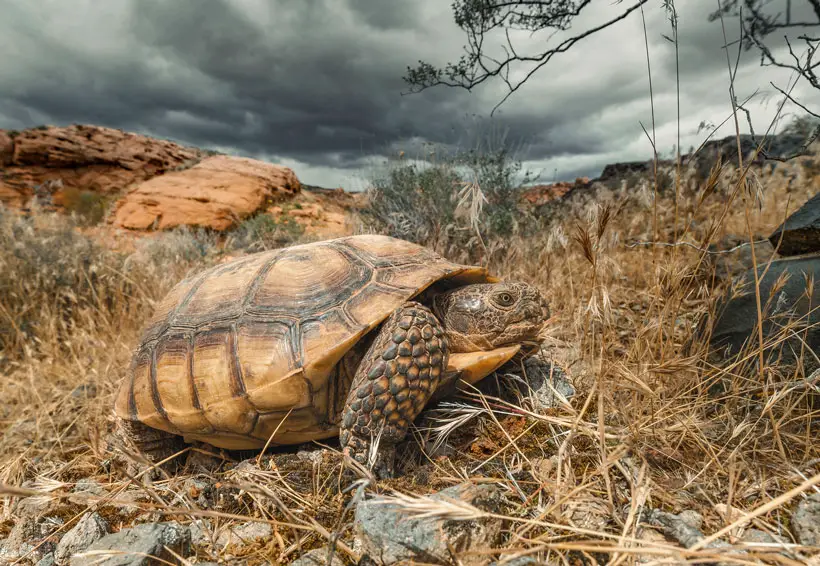
A publication claims that the US Endangered Species Act was used to declare the Desert tortoise as a vulnerable species in 1990 to combat its rapidly dwindling population.
- Mating and Breeding: Usually, the spring and early summer seasons are when Desert tortoises breed. Females lay their eggs in small holes in the ground after mating, where they will incubate for several months before hatching.
4. Sonoran Desert Tortoise
The Sonoran Desert tortoise is a fascinating animal that has evolved to thrive in the harsh desert environment.
- Scientific name: Gopherus morafkai
- Lifespan: These tortoises can live up to 80 years or more.
- Diet: Desert Tortoises feed on a variety of plants, including grasses, cacti, flowers, herbs, and shrubs. They are particularly fond of the pads and fruits of prickly pear cacti.
- Conservation Status: The Sonoran Desert Tortoise is listed as a threatened species under the U.S. Endangered Species Act. Their populations have been declining due to various factors, including urbanization, agriculture, and deforestation.
- Range and Habitat Preferance: The Sonoran Desert Tortoise is a species of tortoise found in the southwestern United States and northwestern Mexico.
- Physical Characteristics: They have a flattened, oval-shaped shell and sturdy legs. Their head is relatively small, and they have a beak-like mouth with a hooked upper jaw.
- Special Characteristics: Interestingly, adult males are generally larger than females, with a longer tail. Have you ever questioned how these tortoises manage to stay alive in the sweltering desert heat?
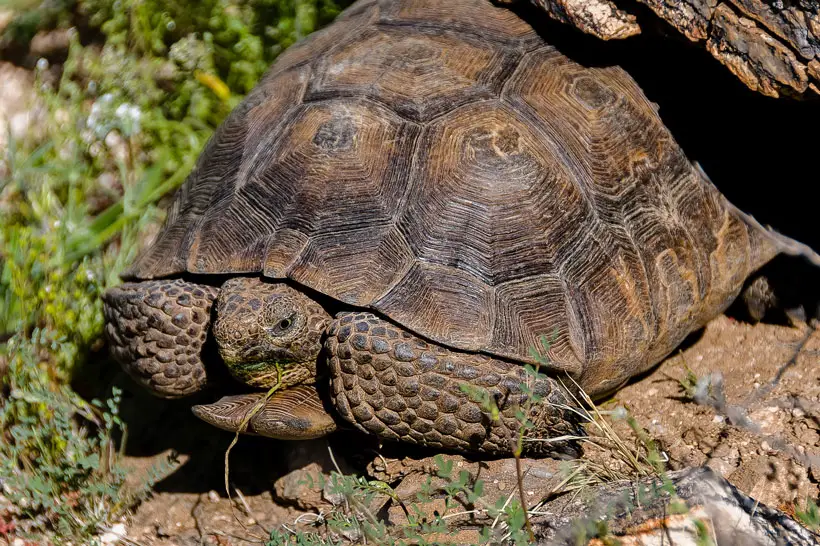
To get away from the heat and cool off, they are known to dig burrows in the dirt. Additionally, they have the ability to hold water in their bladder for up to two weeks, which helps them endure the dry desert climate.
- Mating and Breeding: These tortoises reproduce between the months of April and July, and the females lay a clutch of three to five eggs in a shallow nest built in the ground.
5. Texas Tortoise
The Texas Tortoise is a fascinating species of tortoise native to the southern United States and northern Mexico. Due to their small size, hardiness, and docile nature, they are sometimes kept as pets.
- Scientific name: The Texas Tortoise is scientifically known as Gopherus berlandieri.
- Lifespan: Texas Tortoises can live up to 50-80 years.
- Diet: In addition to being herbivorous, Texas Tortoises are also known to be opportunistic feeders, and they will eat a variety of plants and insects if it’s available.
- Range and Habitat Preferance: It is primarily found in the southern regions of Texas, including the Rio Grande Valley, and extends into northeastern Mexico. Texas tortoises enjoy hot, dry habitats, including grasslands, shrublands, and desert scrub.
- Physical Traits: The Texas Tortoise is a medium-sized tortoise. Their upper shell has a domed form and is often brown or grayish in color. They can also dig with their forelimbs, which allows them to make burrows for thermoregulation and protection from harsh temperatures.
- Conservation Status: Currently, the Texas Tortoise is considered to be a threatened species. The loss of habitat brought on by agriculture, urbanization, and illicit collecting for the pet trade have all contributed to the species’ dwindling numbers.
- Mating and Breeding: Breeding usually occurs in the early spring or late fall. Females lay small clutches of 1-5 eggs in sandy soil nests, and incubation lasts for about 70-90 days.
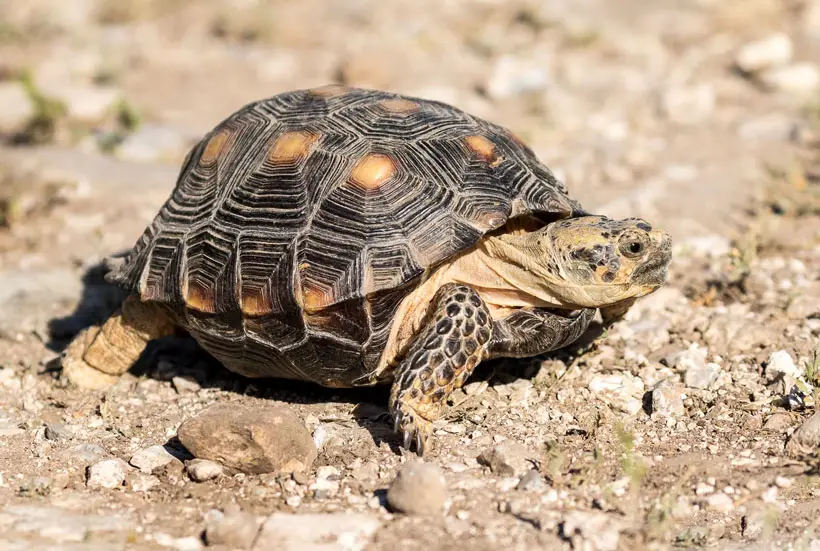
What Are The Non-Native Tortoise Species Found In The United States?
Do you know that in addition to native tortoises, there are a number of non-native species in the United States? These tortoises were either intentionally or unintentionally introduced to the region and are not native to the area.
They are generally captured in the wild and brought to the United States as pets or for research purposes. If you are curious, we have listed some of the common non-native tortoise species found in the United States below:
1. Afghan Tortoise (Testudo horsfieldii)
Have you ever heard of the Afghan tortoise? These cute creatures can grow up to 20 cm long and have a dark-brown, smooth, high-domed shell. They are indigenous to the rocky, arid areas of Afghanistan, Pakistan, and Iran.
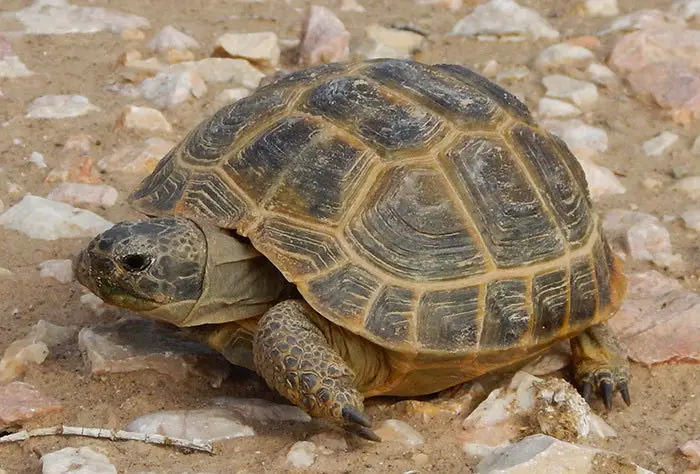
They have evolved specifically to survive in settings that resemble the desert. In captivity, they can live up to 60 years and primarily eat weeds and grasses.
2. African Spurred Tortoise (Centrochelys sulcata)
The African Spurred Tortoise, also called the Sulcata Tortoise, is an amazing animal. African Spurred Tortoises are not native to the USA but can be found in various regions across Africa, particularly in the sub-Saharan countries like Senegal, Chad, Sudan, and Niger.
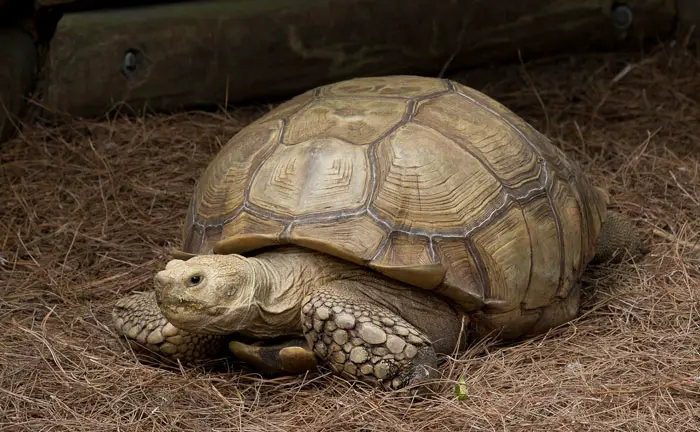
Do you know that they have a lifespan of up to 100 years in the wild? Their scale-covered, brownish-yellow shell gives these tortoises an eye-catching appearance.
With a maximum length of 30 inches and a maximum weight of 200 pounds, these tortoises are the third largest tortoise on the planet. Their innate capacity to dig deep tunnels to hide from harsh weather and predators is one of their most outstanding traits.
3. Red-Footed Tortoise (Chelonoidis carbonarius)
Red-footed tortoises are typically found in South and Central American woods and grasslands. These tortoises stand out in the crowd because of their reddish-brown shells and distinctive red and yellow stripes on their head and legs.
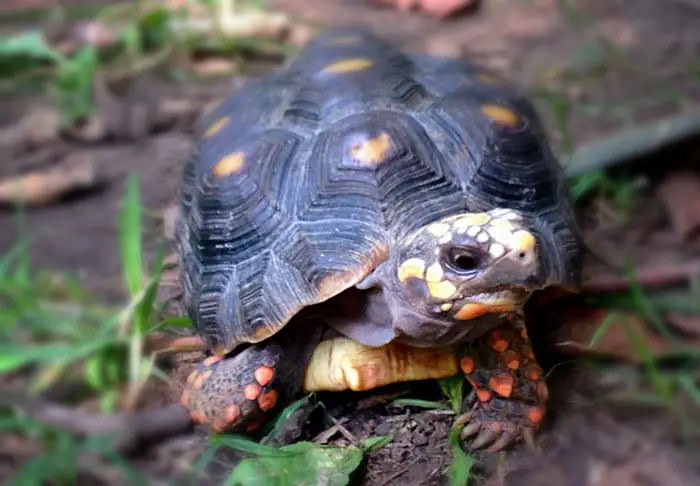
They make the ideal long-term pet due to their lifespan of up to 50 years. In addition, they are not picky eaters and eat a variety of foods, including fruits, fungi, leaves, and even insects.
The Red-footed Tortoise is unique in that it can spend hours basking in the sun, which aids in controlling its body temperature and digestion.
4. Berlandier’s Tortoise (Gopherus berlandieri)
Berlandier’s Tortoise is an intriguing and unique species! It is incredible to consider how these little tortoises, which are endemic to Northern Mexico and Southern Texas in the United States, have adapted to thrive in such harsh surroundings.
They have a distinct appearance, with a light-colored shell and dark, mottled markings on their limbs and head, which helps them blend in with their surroundings.
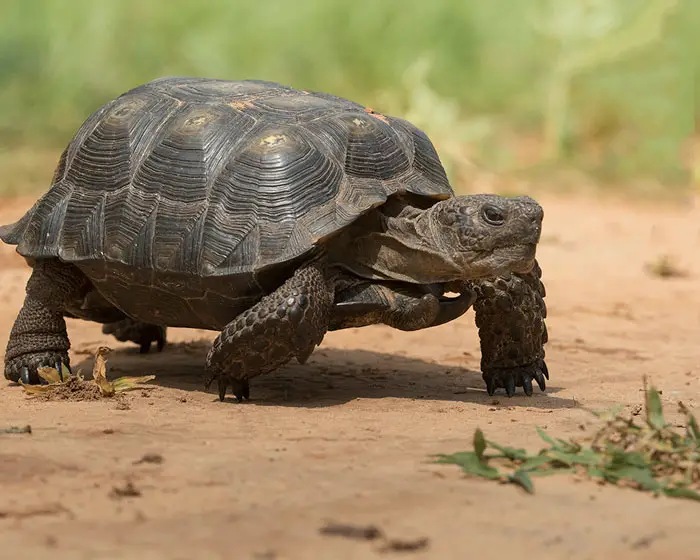
In addition to their unusual look, they are renowned for their hardiness, being able to survive in areas with little access to vegetation and water. Nevertheless, despite their toughness, they are listed as a vulnerable species because of habitat loss and hunting.
5. Yellow-footed Tortoise (Chelonoidis denticulata)
The Yellow-footed Tortoise is native to the lush rainforests of South America. They are known to have a brownish-black shell with vibrant yellow markings on their legs and head.
They are also one of the largest species of tortoise found in South America, growing up to 16 inches long and 35 pounds in weight. The Yellow-footed Tortoise’s love of water is among its most fascinating traits.
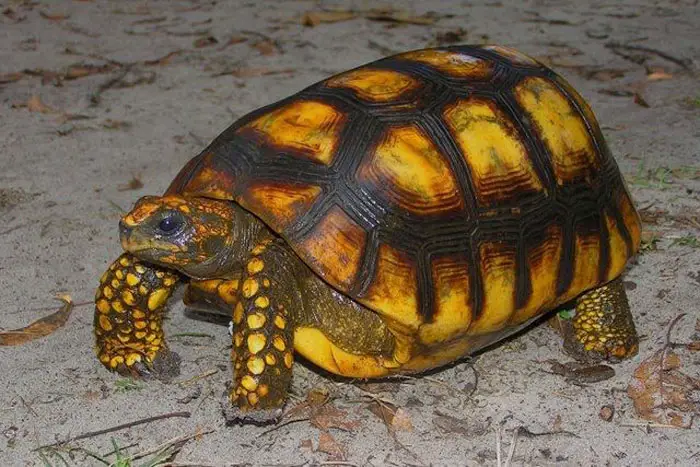
They have a unique ability to swim and are frequently seen soaking in shallow water to stay hydrated. Yellow-footed Tortoises are known for their gentle nature, making them great pets for Tortoise owners.
6. Marginated Tortoise (Testudo marginata)
Did you know that the Marginated Tortoise is one of the most popular tortoise species kept as pets in the United States?
Despite being native to southern Europe, northwest Africa, and western Asia, they have found a home in American households due to their adorable appearance and calm nature.
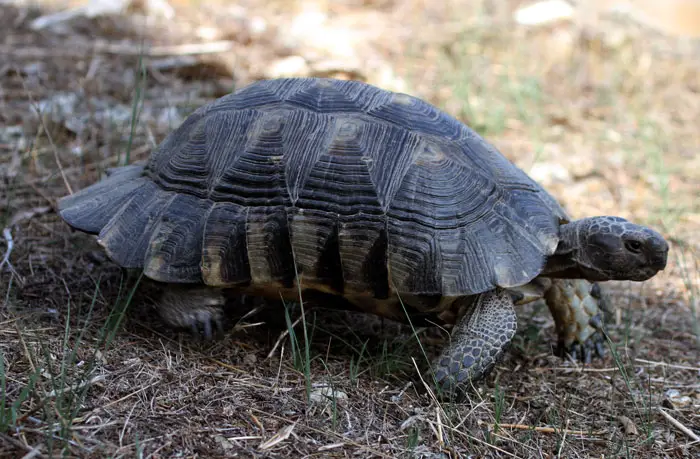
They have a brown shell with distinctive growth rings and can grow up to 14 inches long. In the wild, they typically have a lifespan of 30-40 years. These tortoises are herbivores and mainly feed on grasses, leaves, and flowers.
7. Hermann’s Tortoise (Testudo hermanni)
The Hermann’s Tortoise is a unique kind of tortoise. They stand out due to their extraordinary skills as well as their high-domed shell, which has diverse colors and markings.
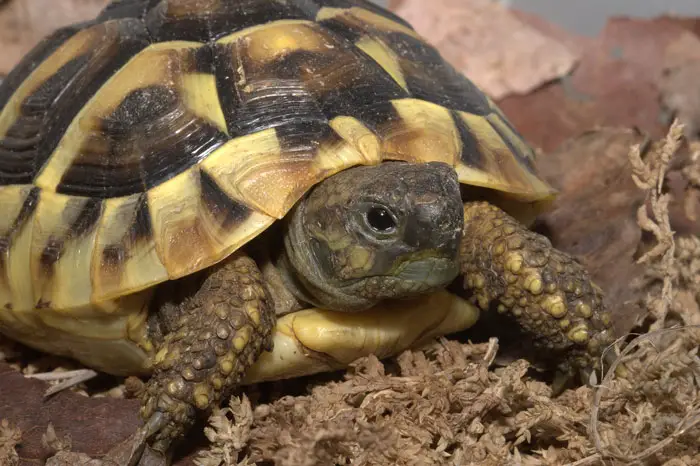
For instance, these tortoises have a remarkable sense of detecting predators. They can sense vibrations through their shell and use them as a natural alarm system to keep themselves safe from harm.
Another fascinating fact about Hermann’s Tortoises is that they can easily climb over obstacles. On top of that, due to their easy upkeep and gentle temperament, they are frequently kept as pets in the United States.
What Are The Threats Tortoises Encounter In The United States?
You may be surprised to learn that various risk factors are threatening the survival of the tortoise species in the United States. It’s extremely worrisome, but it’s important to be aware of the potential dangers so we can take action to help safeguard these incredible animals.
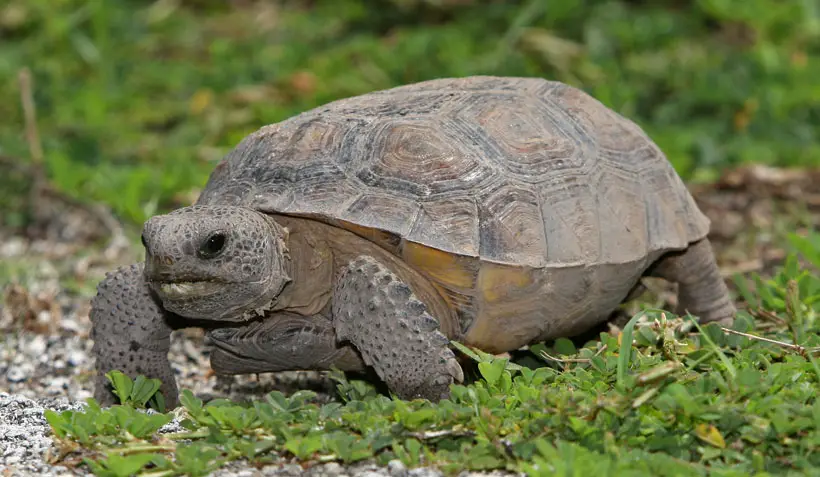
Check out the list below to learn about the threats to tortoise species in the US:
- Habitat loss: A study found that habitat loss, degradation, and fragmentation put 80% of the tortoise species that exist in the United States in danger of going extinct.
As human populations rise and encroach on natural areas in the United States, the habitat of tortoises is harmed or fragmented, which can lead to a decline or loss of tortoise populations.
- Human interference: Activities including off-road vehicle use, mining, and recreational endeavors can have an impact on tortoises. These actions raise the possibility of unintentional harm or death to tortoises, interrupt their behavior, and ruin their habitat.
- Overharvesting of tortoises for their eggs and for human consumption: The populations of these animals are seriously threatened by the illegal trade in tortoises and their eggs.
The over-collection of tortoises as a result of demand from the food, traditional medicine, and pet industries has led to a decline in their populations.
- A changing climate: Populations of tortoises are seriously at risk from climate change. According to a study, the American Southwest and northern Mexico are expected to see significant effects from rising aridity.
Turtle populations may be impacted by drought, reduced food supply, and altered vegetation brought on by rising temperatures.
- Disease susceptibility: Tortoises are extremely vulnerable to several illnesses, and the spread of new diseases has the potential to have a catastrophic effect on their populations.
For instance, Upper Respiratory Tract Disease has been identified as a severe hazard to tortoises in the United States and is responsible for causing significant mortality in wild populations.
How Can We Prevent the Extinction of Tortoises in The United States?
You can take certain actions to lessen these risks and prevent the extinction of the tortoise species in the United States. The key actions individuals, organizations, and governments should take are as follows.
- Employing rotational grazing systems: Rotational grazing techniques can be used to prevent overgrazing in particular places, allowing habitats for tortoises to recover and rejuvenate.
Additionally, to ensure that there are enough resources for both tortoises and livestock, feeding stations can be properly placed or alternate fodder sources might be offered.
- Address climate change issues: Reduce greenhouse gas emissions and promote sustainable lifestyles to address the root causes of climate change. Tortoises face serious problems as a result of climate change, which affects their habitats, food supplies, and reproduction.
- Public Education & Outreach: Spread knowledge about the significance of tortoise conservation among the general public, local communities, and stakeholders.
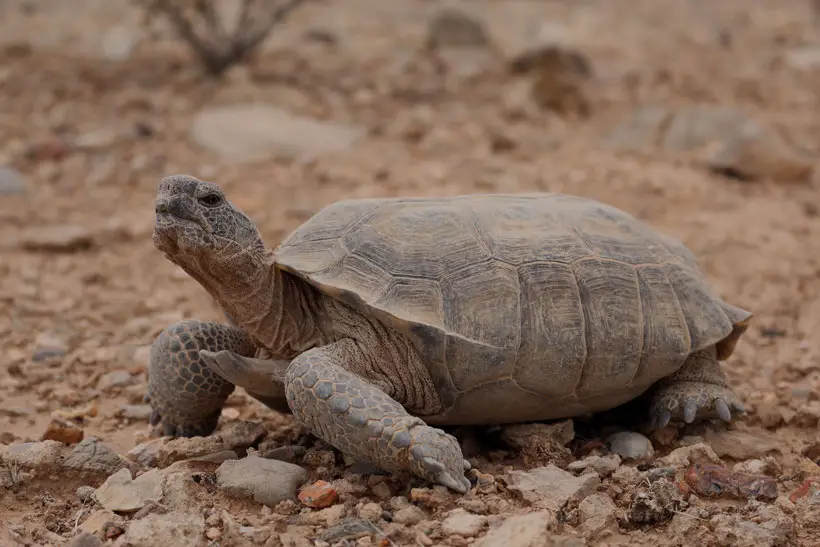
People should be made aware of the dangers that tortoises face, the importance of these animals to the environment, and what each of us can do to help safeguard them.
- Establish captive breeding programs: Create captive breeding initiatives to boost turtle populations and genetic diversity.
Additionally, make an effort to restore tortoises into habitats that are appropriate for them in areas where they have been locally extinct but make sure the ecosystems can support their survival.
- Conservation of Habitat: It is essential to safeguard and maintain the natural habitats of tortoises. This entails identifying significant habitats for tortoises and taking action to protect and restore these sites.
FAQs
Explore the commonly asked questions listed below for additional details on the many species of tortoise found in the United States.
Female tortoises often have flat or slightly convex plastrons, while males typically have concave plastrons. Additionally, males frequently have longer tails than females, which can help them balance while mating.
Many zoos and wildlife parks in the US offer tortoise exhibits, and some places, like the Mojave Desert, are well renowned for their tortoise populations. Just keep in mind to be gentle when handling a tortoise.
No, not every type of tortoise found in the country is at risk of extinction. However, several species, including the Gopher tortoise and the Desert tortoise, are regarded as threatened due to habitat loss and other factors.
Final Words
Different species of tortoise can be found in the United States. These gorgeous animals, such as the tough desert tortoise, the charming Texas tortoise, or the diligent gopher tortoise, are essential to sustaining ecological balance and the USA’s natural treasures.
Unfortunately, several of these tortoise species are in grave danger of extinction due to climate change, habitat degradation, and human activity.
It is both worrying and upsetting to think that these adorable creatures might not survive if we don’t take action to protect them. By doing this, you not only safeguard these amazing species but also the planet’s biodiversity.
So, what can you do to help out? You may start by lowering your carbon footprint, refraining from single-use plastics, and encouraging conservation activities. Remember, small deeds can have a significant impact!

